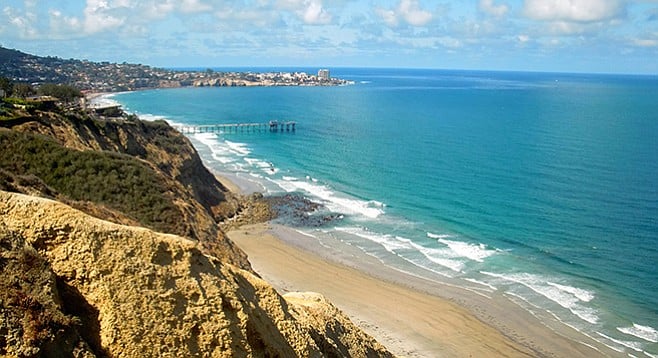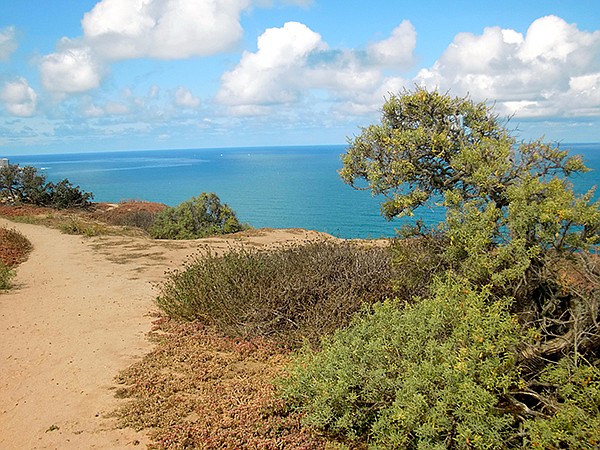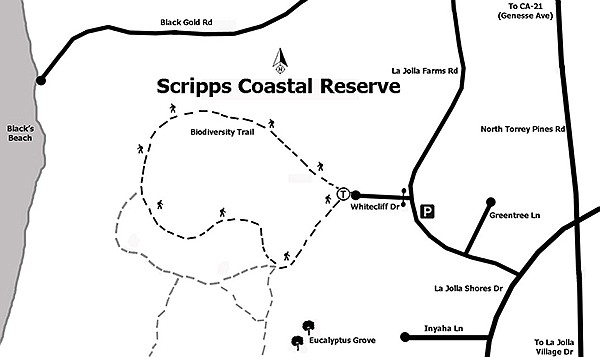 Facebook
Facebook
 X
X
 Instagram
Instagram
 TikTok
TikTok
 Youtube
Youtube

The Scripps Coastal Reserve, or ”the Knoll,” offers spectacular views of the Pacific Ocean from coastal bluffs and an easy walk through coastal sage-scrub habitat. Owned by the University of California as part of their larger Natural Reserve System, the Scripps Coastal Reserve aims to provide a dedicated space for scientific research, education, and public service, contributing to stewardship and understanding of California’s diverse ecosystems. The Biodiversity Trail offers an easy walk, with many signs posted along the trail informing visitors of the area’s natural history, including plant and animal life and geology.
This route begins by walking through areas dominated by California sagebrush (Artemisia californica) and large stands of California bush sunflower (Encelia californica), which bloom in great abundance from January to March. Following the trail to the edge of the cliff, you will be rewarded with a view of the Pacific Ocean, including the surf break at Black’s Beach north of the overlook. A paved road offering pedestrian access to the beach can be found further north of the reserve, past Black’s Canyon, but there is no beach access from the Biodiversity Trail. The view to the ocean will be overlooking the Scripps and La Jolla submarine canyons, which plunge to over 730 meters below the surface. Large marine life, such as gray whales, often take advantage of the deep waters off the coast during their annual migrations — keep a lookout from December to April. Kelp beds in the La Jolla Cove to the south provide habitat to many species of marine life and appear slick on the water’s surface. Over 265 fish species have been documented in the cove, representing half of all marine fish species found in California. Looking down between the overlook and the Scripps Research Pier, an exposed rocky intertidal zone at Dike Rock can be seen when water is left behind in pools at low tide.
Continuing along the trail, look inland to see an area under various stages of restoration. Over 80 percent of original coastal sage scrub was lost by 1980 to agriculture and urbanization, with remaining fragments facing pressure from invasion by nonnative plant species. Invasive plant species of particular concern include crystalline ice plant (Mesembryanthemum crystallinum, originating from South Africa), recognized by water “bubbles” covering this prostrate red succulent. In addition, others originating from the Mediterranean Basin and Eurasia such as black mustard (Brassica nigra), redstem stork’s bill (Erodium cicutarium), and various grasses (including Bromus madritensis and Bromus diandrus). These invaders can change habitat suitability for vertebrate and invertebrate species, displace native plants, and also affect other ecosystem goods and services such as carbon storage and erosion control. Look for baby shrub seedlings that have been planted in areas where exotic plants have been removed, but please stay on the main path so as not to hinder their establishment. Past restoration and conservation efforts at the Knoll have resulted in several nesting pairs of the federally threatened California gnatcatcher (Polioptila californica) — listen for their catlike call.
Along this western edge of the reserve, look for an earthen bunker with two cuts into the bluff. During World War II, gun emplacements were constructed here to protect the coast.

On the return inland, look for a large bladderpod (Peritoma arborea) on which often found is a red-throated, year-round resident of San Diego County — Anna’s hummingbird (Calypte anna). Upon closer inspection of the bladderpod, there are likely harlequin bugs (Murgantia histrionica), members of the stinkbug family with bright orange markings on their black back. Note the wings on bugs are crossed, forming an X or triangle, versus the stink beetle with its fused parallel wing cases.
Closing the loop to the trailhead, notice the barrel cacti (Ferocactus viridescens) tucked beyond pockets of sagebrush, many of which were saved and transplanted from area developments. Barrel cacti are often visited by native ant species for both protection and pollination, and the ants, in turn, are an important food source for the conspicuous, yet shy, horned lizards. Along this portion of the trail, Sumner Canyon drops off to the south. Other plants likely to be encountered on the trail include lemonadeberry (Rhus integrifolia), coyote brush (Baccharis pilularis), and California buckwheat (Eriogonum fasiculatum). Careful observers may also be rewarded with desert cottontail, rattlesnake, western fence lizard, or wrentit sightings.

Distance from downtown San Diego: 16 miles. Allow 20 minutes driving time (La Jolla). Take I-5 N to the La Jolla Village Dr. exit. Turn left (west) on La Jolla Village Dr., and continue onto N. Torrey Pines Rd. Turn left onto La Jolla Shores Dr., and nearly immediately, turn right on La Jolla Farms Rd. After 0.1 mile, the gate for the Scripps Coastal Reserve will be on the left. Limited street parking is available on La Jolla Farms Rd., and additional parking may be found on La Jolla Shores Dr. or on the University of California, San Diego campus.
Hiking length: 0.5-mile loop along the Biodiversity Trail. Allow 30 minutes to hike and read informative trail signs.
Difficulty: Easy, with no measurable gain/loss of elevation.
Hours open: 8 a.m. to sunset. No dogs or bicycles allowed. No facilities.


The Scripps Coastal Reserve, or ”the Knoll,” offers spectacular views of the Pacific Ocean from coastal bluffs and an easy walk through coastal sage-scrub habitat. Owned by the University of California as part of their larger Natural Reserve System, the Scripps Coastal Reserve aims to provide a dedicated space for scientific research, education, and public service, contributing to stewardship and understanding of California’s diverse ecosystems. The Biodiversity Trail offers an easy walk, with many signs posted along the trail informing visitors of the area’s natural history, including plant and animal life and geology.
This route begins by walking through areas dominated by California sagebrush (Artemisia californica) and large stands of California bush sunflower (Encelia californica), which bloom in great abundance from January to March. Following the trail to the edge of the cliff, you will be rewarded with a view of the Pacific Ocean, including the surf break at Black’s Beach north of the overlook. A paved road offering pedestrian access to the beach can be found further north of the reserve, past Black’s Canyon, but there is no beach access from the Biodiversity Trail. The view to the ocean will be overlooking the Scripps and La Jolla submarine canyons, which plunge to over 730 meters below the surface. Large marine life, such as gray whales, often take advantage of the deep waters off the coast during their annual migrations — keep a lookout from December to April. Kelp beds in the La Jolla Cove to the south provide habitat to many species of marine life and appear slick on the water’s surface. Over 265 fish species have been documented in the cove, representing half of all marine fish species found in California. Looking down between the overlook and the Scripps Research Pier, an exposed rocky intertidal zone at Dike Rock can be seen when water is left behind in pools at low tide.
Continuing along the trail, look inland to see an area under various stages of restoration. Over 80 percent of original coastal sage scrub was lost by 1980 to agriculture and urbanization, with remaining fragments facing pressure from invasion by nonnative plant species. Invasive plant species of particular concern include crystalline ice plant (Mesembryanthemum crystallinum, originating from South Africa), recognized by water “bubbles” covering this prostrate red succulent. In addition, others originating from the Mediterranean Basin and Eurasia such as black mustard (Brassica nigra), redstem stork’s bill (Erodium cicutarium), and various grasses (including Bromus madritensis and Bromus diandrus). These invaders can change habitat suitability for vertebrate and invertebrate species, displace native plants, and also affect other ecosystem goods and services such as carbon storage and erosion control. Look for baby shrub seedlings that have been planted in areas where exotic plants have been removed, but please stay on the main path so as not to hinder their establishment. Past restoration and conservation efforts at the Knoll have resulted in several nesting pairs of the federally threatened California gnatcatcher (Polioptila californica) — listen for their catlike call.
Along this western edge of the reserve, look for an earthen bunker with two cuts into the bluff. During World War II, gun emplacements were constructed here to protect the coast.

On the return inland, look for a large bladderpod (Peritoma arborea) on which often found is a red-throated, year-round resident of San Diego County — Anna’s hummingbird (Calypte anna). Upon closer inspection of the bladderpod, there are likely harlequin bugs (Murgantia histrionica), members of the stinkbug family with bright orange markings on their black back. Note the wings on bugs are crossed, forming an X or triangle, versus the stink beetle with its fused parallel wing cases.
Closing the loop to the trailhead, notice the barrel cacti (Ferocactus viridescens) tucked beyond pockets of sagebrush, many of which were saved and transplanted from area developments. Barrel cacti are often visited by native ant species for both protection and pollination, and the ants, in turn, are an important food source for the conspicuous, yet shy, horned lizards. Along this portion of the trail, Sumner Canyon drops off to the south. Other plants likely to be encountered on the trail include lemonadeberry (Rhus integrifolia), coyote brush (Baccharis pilularis), and California buckwheat (Eriogonum fasiculatum). Careful observers may also be rewarded with desert cottontail, rattlesnake, western fence lizard, or wrentit sightings.

Distance from downtown San Diego: 16 miles. Allow 20 minutes driving time (La Jolla). Take I-5 N to the La Jolla Village Dr. exit. Turn left (west) on La Jolla Village Dr., and continue onto N. Torrey Pines Rd. Turn left onto La Jolla Shores Dr., and nearly immediately, turn right on La Jolla Farms Rd. After 0.1 mile, the gate for the Scripps Coastal Reserve will be on the left. Limited street parking is available on La Jolla Farms Rd., and additional parking may be found on La Jolla Shores Dr. or on the University of California, San Diego campus.
Hiking length: 0.5-mile loop along the Biodiversity Trail. Allow 30 minutes to hike and read informative trail signs.
Difficulty: Easy, with no measurable gain/loss of elevation.
Hours open: 8 a.m. to sunset. No dogs or bicycles allowed. No facilities.
Comments